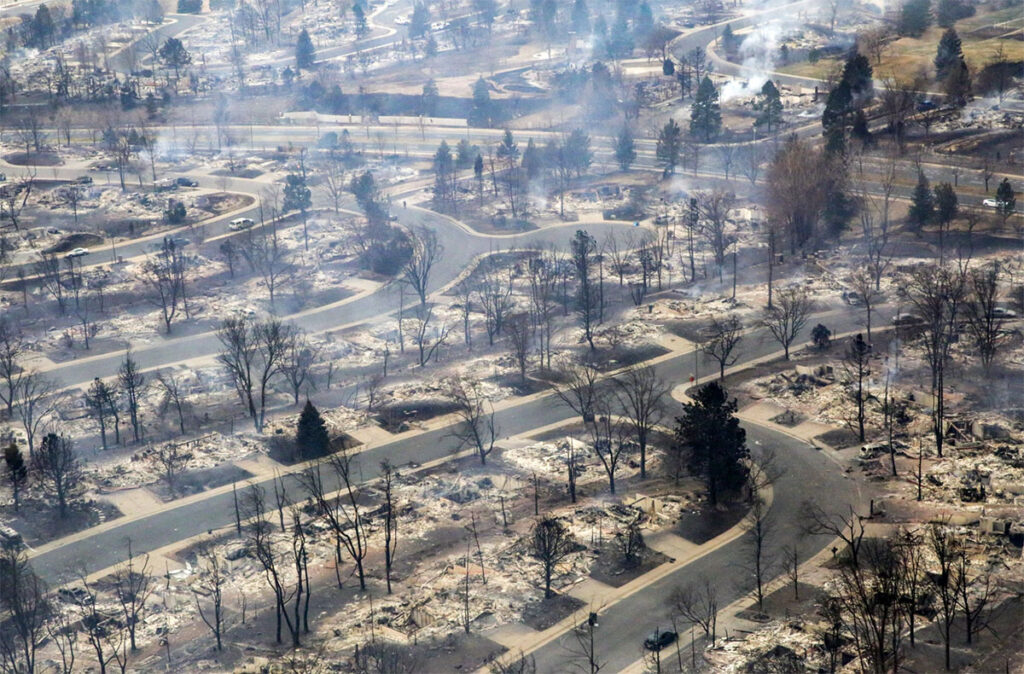
DRY WEATHER AND STRONG WINDS HELP SPREAD FIRES
Sofía Márquez / El Comercio de Colorado
Haga click aquí para leer la versión en español
The first lawsuit in connection with the wildfire that destroyed more than 1,000 homes and other buildings in Boulder County in December 2021 has been filed. The lawsuit claims that sparks from a power line were responsible for starting the fire on Marshall, Superior. The lawsuit filed against Xcel Energy says its power lines and equipment were a “substantial factor” in the cause, origin and continuation of the wildfire, which was fanned by high winds.
The suit assures witnesses saw the fire ignite near a power line in the area where authorities say the wildfire started. A witness also videotaped sparks coming from a malfunctioning power line which then turned into the wildfire. Michelle Aguayo, a spokeswoman for Xcel, said the company was reviewing the lawsuit, but said she has yet to see any incriminating evidence.
Year-round forest fires
As investigations into the Marshall Fire continue, it is important to note that in the past year, there has been an unusual spike in forest fires in Colorado. The most devastating being the Marshall fire in Superior, located in Boulder County, which burned around 6,000 acres, while the most recent also happened in Boulder on March 26th, burning less than 200 acres. Though they are different in size, they have one key thing in common. Both of these fires happened outside of wildfire season.
In Colorado, wildfire season has historically been a four-month period of time in the middle of the summer where temperatures are at their highest. Today, the average core wildfire season is 78 days longer than in the 1970’s, with Colorado experiencing large fires every month of the year. Recent research has suggested that heat, drought, and fast winds, which are associated with global warming, are the main reasons for the increase in larger and stronger fires.
Residential areas most affected in Colorado
“The kind of catastrophic fires that cause a lot of harm are the ones that are started accidentally by humans on windy, dry days. I think sometimes people forget just how easy it is for a spark to create a fire on the landscape,” tells us Daniel Swain, a UCLA scientist that specializes on extreme weather events on a warming planet. He stresses that while these recent fires in the Denver metro area have not been as large as others around the country, the issue is that they are happening close to residential neighborhoods.
“Sometimes these fires are hard to avoid, but sometimes they are easy to avoid. Here in Boulder, the same day we saw these other fires, there were people with campfires in the wind, throwing cigarettes out the car window, somebody juggling fire sticks…” Swain tells us that the only way to ensure that one is not responsible for starting an accidental fire is to watch out for the weather conditions for the day, and practice basic fire safety.
How can we help?
The Division of Fire Prevention and Control has several resources on their website which outlines how residents can help lower the chances of a wildfire starting by accident. These include sweeping and throwing away any flammable material such as dry leaves and grass, and being cognizant that the smallest things can create a spark. Lawnmowers and power equipment should not be used on hot, dry days, and when using them, ensure you have a fire extinguisher at hand.








otras noticias
La Dame Blanche closes the XIII Americas Latino Eco Festival
More than $2 million for 3,570 workers
Xavier Becerra highlights the positive impact of 988 on managing mental health crises